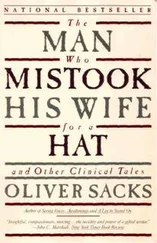I have heard similar descriptions from other people who have both CBS and some dementia. Janet B. likes to listen to audiobooks and sometimes finds herself joined by a hallucinatory group of fellow listeners. They listen intently but never speak, do not respond to her questions, and seem unaware of her presence. At first, Janet realized that they were hallucinatory, but later, as her dementia advanced, she insisted that they were real. Once when her daughter was visiting and said, “Mom, there’s no one here,” she got angry and chased her daughter out.
A more complex delusional overlay occurred while she was listening to a favorite show on television. It seemed to Janet that the television crew had decided to use her apartment, and that it was set up with cables and cameras, that the show was actually being filmed at that moment in front of her. Her daughter happened to telephone her during the show, and Janet whispered, “I have to be quiet — they’re filming.” When her daughter arrived an hour later, Janet insisted that there were still cables all over the floor, adding, “Don’t you see that woman?”
Even though Janet was convinced of the reality of these hallucinations, they were entirely visual. People pointed, gestured, mouthed, but made no sound. Nor did she have any sense of personal involvement; she found herself in the midst of strange happenings, yet they seemed to have nothing to do with her. In this way they retained the typical character of CBS hallucinations, even though she insisted that they were real.
While the romantic use of sensory deprivation, as that of vision-producing drugs, has diminished since the 1960s, its political use is still horrifyingly common in the treatment of prisoners. In a 1984 paper on “hostage hallucinations,” Ronald K. Siegel pointed out that such hallucinations can be magnified sometimes to madness, especially when combined with social isolation, sleep deprivation, hunger, thirst, torture, or the threat of death.
There may be severe visual impairment or complete blindness without a hint of CBS, and this might seem to imply that visual deprivation alone is not a sufficient cause for it. But we are still ignorant as to why some people with visual problems get CBS and others do not.
Molly Birnbaum, an aspiring chef who became anosmic after being struck by a car, has described the anosmic’s predicament eloquently in her memoir Season to Taste .
Among these other conditions is infection with the herpes simplex virus, which can attack nerves (including sometimes the olfactory nerves), both impairing and stimulating them. The virus can remain dormant for long periods, sequestered in nerve ganglia, and suddenly reemerge at intervals of months or years. One man, a microbiologist, wrote to me: “In the summer of 2006, I began to ‘smell things,’ a faint pervasive odor that I could not identify (my best guess was … wet cardboard).” Prior to this, he said, “I had a highly sensitive nose, and was able to identify my laboratory cultures by smell alone, or subtle differences in organic solvents, or faint perfumes.”
He soon developed a constant hallucination of the smell of rotting fish, which faded only after a year had passed, along with most of his “olfactory acuity and the subtlety of most foods.” He wrote:
Certain odors are completely gone — feces(!), baking bread, or cookies, roasting turkey, garbage, roses, the fresh soil smell of Streptomyces … all gone. I miss the smells of Thanksgiving, but not the smell of public toilets.
The dysosmia and phantosmia were due to a reemergence of the herpes simplex 2 which he had contracted many years before, and he is intrigued that these are always preceded by hallucinatory smells. He writes, “I smell the onset of herpes reactivation. A day or two prior to the onset of a neuritis episode, I again have olfactory hallucinations of the last strong smell I noticed. [This smell] persists during the neuritis and fades as the neuritis fades.… The strength of the hallucinations is correlated with the severity of the generalized neuritis.”
The real patients, however, were more observant. “You’re not crazy,” said one. “You’re a journalist or a professor.”
Freud was not unsympathetic to the notion of telepathy; his “Psychoanalysis and Telepathy” was written in 1921, though published only posthumously.
Recently, a number of people who hear voices have organized networks in various countries asserting their “right” to hear voices, to have them respected and not dismissed as trivial or pathological. This movement and its significance are discussed by Ivan Leudar and Philip Thomas in their book Voices of Reason, Voices of Madness and by Sandra Escher and Marius Romme in their 2012 review of the subject.
Judith Weissman, in her book Of Two Minds: Poets Who Hear Voices , presents strong evidence, drawn especially from what poets themselves have said, that many of them, from Homer to Yeats, have been inspired by true auditory vocal hallucinations, not just metaphorical voices.
Jaynes thought that there might be a reversion to “bicamerality” in schizophrenia and some other conditions. Some psychiatrists (such as Nasrallah, 1985) favor this idea or, at the least, the idea that the hallucinatory voices in schizophrenia emanate from the right side of the brain but are not recognized as one’s own, and are thus perceived as alien.
Sarah Lipman has noted, in her blog (www.reallysarahsyndication.com), the phenomenon of “phantom rings” as people imagine or hallucinate the ringing of their cell phones. She links this to a state of vigilance, expectation, or anxiety, as when she thinks she may hear a knock at the door or her baby crying. “Part of my consciousness,” she wrote to me, “is straining to monitor for the sound. It seems to me that it is this hyper-alert state that generates the phantom sounds.”
There may be paroxysmal musical hallucinations during temporal lobe seizures. But in such cases, the musical hallucinations have a fixed and invariable format; they appear along with other symptoms (perhaps visual or olfactory hallucinations or a sense of déjà vu) and at no other time. If the seizures can be controlled medically or surgically, the epileptic music will cease.
Most people who get musical hallucinations are elderly and somewhat deaf; it is not unusual for them to be treated as if demented, psychotic, or imbecilic. Jean G. was hospitalized after she had an apparent heart attack, and a few days later, she began “hearing a male choir in the distance as if it were coming through the woods.” (Several years later, when she wrote to me, she still heard this, especially in times of stress or when she was extremely tired.) But, she said, “I quickly stopped talking about this type of music when faced with a nurse asking me, ‘Do you know your name? Do you know what day this is?’ I responded back, ‘Yes, I know what day this is — it is the day I am going home.’ ”
I have written at much greater length about musical hallucinations (as well as intrusive musical imagery, or “earworms”) in my book Musicophilia .
My colleague Steven Frucht described to me a hallucination experienced by a patient of his, an intellectually intact woman who has been treated with medications for Parkinson’s disease for more than fifteen years. Her hallucinations, however, started only a year ago. She also sees a cat — a grey cat with “beautiful” eyes which wears a serene, “beautiful expression” on its face and seems to be of a most friendly disposition. To her own surprise (for she has never liked cats), she enjoys visits from the grey cat and worries that “something may happen to him.” Though she knows the cat is a hallucination, he seems very real to her: she can hear him coming, feel the warmth of his body, and touch him if she wishes. The first time the cat appeared, wanting to rub against her legs, she said, “Don’t touch me, don’t get too close.” And since then the cat has kept a decorous distance. Occasionally, in the afternoon, the cat is joined by a large black dog. When Dr. Frucht asked her what happens when the cat sees the dog, she replied that the cat “looks away and is peaceful.” She later remarked, “He is fulfilling his purpose in coming to visit me.”
Читать дальше












